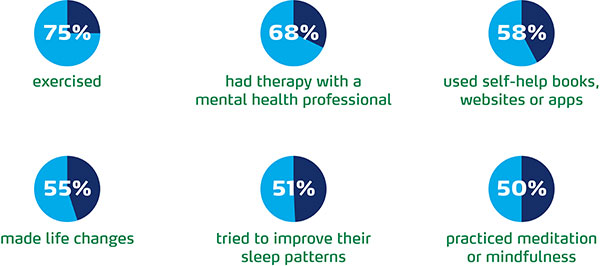The fact is, women suffer from depression more than men worldwide. The World Health Organization reports that 10.4% of women in the United States are likely to experience depression. That’s almost twice the rate for men (5.5%).1 This rate holds true regardless of race, age or income level.2 Local reporting by the Connecticut Health Investigative Team showed that our state is no exception.
Depression is more than feeling sad
People with depression describe it as sadness that won’t go away. They sometimes feel hopeless and worthless. There are other symptoms, too. Those include trouble sleeping, being irritable, having a hard time concentrating and losing interest in everyday activities.
There are many potential causes of depression. For women, biological factors such as premenstrual syndrome, pregnancy and childbirth, infertility and menopause may contribute to depression. There are also social factors, including poverty, work and family responsibilities and sexual or physical abuse.3
Depression often leads to other mental health conditions, such as anxiety, eating disorders and drug or alcohol abuse.3 It can all seem overwhelming, but it’s encouraging to know that depression can be treated.
Women say treatment helped
The National Institute of Mental Health notes that most adults see improved depression symptoms through the use of antidepressants, talk therapy or a combination of both.4
We surveyed a panel of women who are ConnectiCare members about their experience with depression and anxiety. Of those who said they’d been diagnosed with depression or anxiety:

Besides medication, health professionals often recommend lifestyle changes when counseling people with depression or anxiety. Of the ConnectiCare members who took our survey and said they’d experienced depression or anxiety:

Ask for help
If you think you have depression or anxiety:
- Talk to someone! You can start with your primary care provider or your obstetrician/gynecologist.
- Find mental health professionals and information on depression at liveandworkwell.com. To look up information on your benefits, find your benefit summary after you log into connecticare.com.
More information on women and depression
The Connecticut Health Investigative Team produced two podcasts, sponsored by ConnectiCare, on women and depression. They include interviews with mental health experts working with women in Connecticut.
You can also read more in our blog posts on aging and depression and seasonal sadness.
Sources:
1. World Health Organization.
2. National Center for Health Statistics.
3. Mayo Clinic.
4. National Institute of Mental Health.
5. Results of an online survey fielded by email to adult women who are ConnectiCare members and others via social media June 5-18, 2018. Of 135 respondents, 83 percent identified themselves as white/Caucasian, 9 percent as Latino/Hispanic, 6 percent as black/African American, 1 percent as Asian and 1 percent as other. Self-reported annual household income of participants: 13 percent – less than $25,000; 35 percent – $25,000 to $49,999; 27 percent – $50,000 to $99,999; 26 percent – $100,000 or more.


